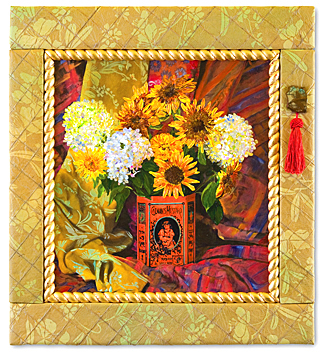Title: “BRASSICA JUNCEA”
(Meaning “brown mustard” in Latin
and pronounced, “ bras-i-kuh june-see-ah”)


|
Size: 19.625” W x 21.75” H
(unframed)
Story:
Brown mustard is thought to have originated in India as early as 3000 B.C. But instead of being used in culinary pursuits, it was believed to have mystic powers and if the seeds were spread around one’s house it would ward off evil spirits. Eventually the plant spread to China, where again instead of being used in food, it became a staple of Chinese medicine. Over time the Romans brought the plant into Europe and specifically in England. By 1814, Colman’s Mustard originated and was one of the many exports of British colonialism, even back to China where its use as a culinary condiment became even more widespread.
Materials:
Acrylic paints on heavy French watercolor paper, bordered with insets of gold leafed wooden braiding, with outside panels wrapped in Japanese oil cloth, over hand-painted Japanese silk, adorned at top right with a fragment from a late 1800’s Japanese raku pot accented with suspended late 1800’s Chinese silk tassel from a wall hanging, all mounted onto archival museum board.
|
|
|
|
Click for enlarged
section of art.
|
Click for enlarged
section of art.
|
|